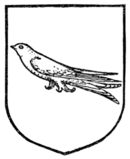correct, but I think it may be an attempt to distinguish between the domestic dove and the wood-pigeon—both of which varieties would be known to the early heraldic artists.
The dove with an olive branch in its beak is constantly and continually met with. When blazoned "proper" it is quite correct to make the legs and feet of the natural pinky colour, but it will be more usually found that a dove is specifically described as "legged gules."
The ordinary heraldic dove will be found most frequently represented with its wings close and holding a branch of laurel in its beak, but it also occurs volant and with outstretched wings. It is then frequently termed a "dove rising."
The doves in the arms of the College of Arms are always represented with the sinister wing close, and the dexter wing extended and inverted. This has given rise to much curious speculation; but whatever may be the reason of the curious position of the wings, there can be very little doubt that the coat of arms itself is based upon the coat of St. Edward the Confessor. The so-called coat of St. Edward the Confessor is a cross patonce between five martlets, but it is pretty generally agreed that these martlets are a corruption of the doves which figure upon his coins, and one of which surmounts the sceptre which is known as St. Edward's staff, or "the sceptre with the dove."
The Wood-Pigeon is not often met with, but it does occur, as in the crest of the arms of Bradbury ["On a wreath of the colours, in front of a demi-wood-pigeon, wings displayed and elevated argent, each wing charged with a round buckle tongue pendent sable, and holding in the beak a sprig of barberry, the trunk of a tree fesswise eradicated, and sprouting to the dexter, both proper "].
The Martlet is another example of the curious perpetuation in heraldry of the popular errors of natural history. Even at the present day, in many parts of the country, it is popularly believed that a swallow has no feet, or, at any rate, cannot perch upon the ground, or raise itself therefrom. The fact that one never does see a swallow upon the ground supports the foundation of the idea. At any rate the heraldic swallow, which is known as the martlet, is never represented with feet, the legs terminating in the feathers which cover the upper parts of the leg (Fig. 465). It is curious that the same idea is perpetuated in the little legend of the explanation, which may or may


